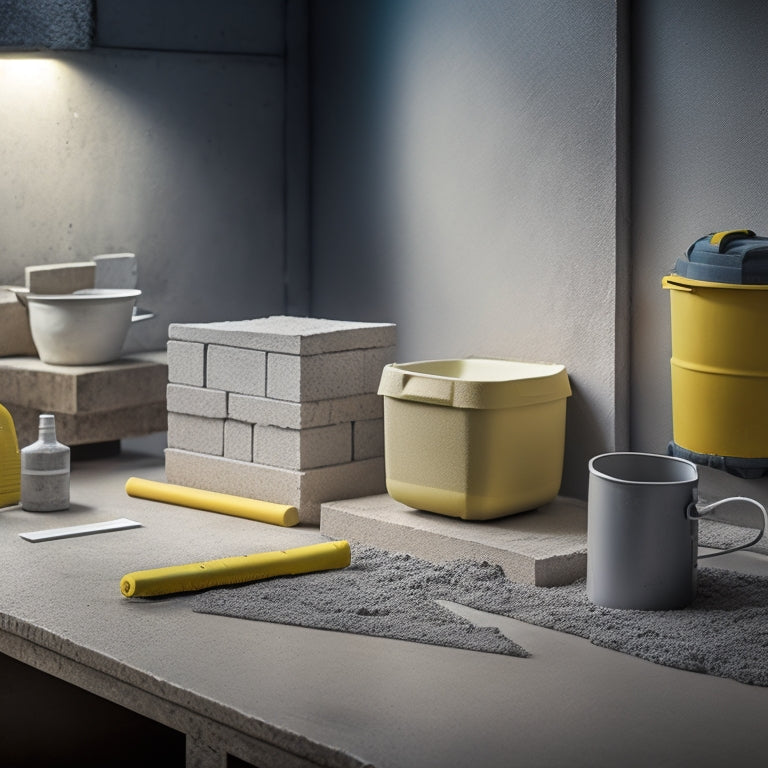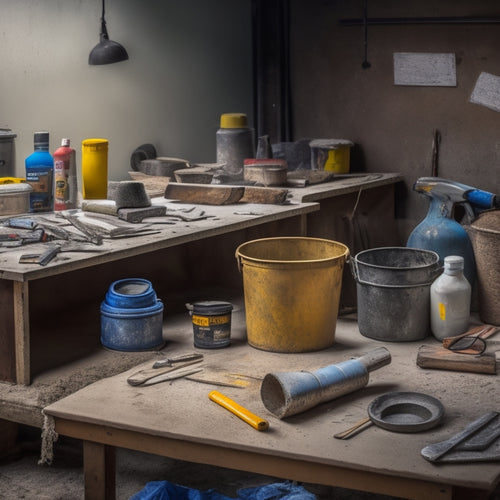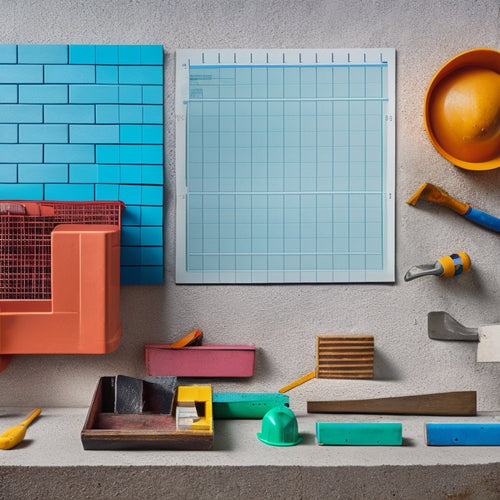
What Tools Do I Need for Concrete Block Laying
Share
You'll need a thorough set of tools to guarantee accurate, efficient, and professional concrete block laying. Essential hand tools like levels, trowels, and jointers are a must, along with concrete block cutting equipment like saws and diamond blades. Mixing and measuring tools, including buckets and mortar gauges, are also vital. Don't forget leveling and alignment tools, safety gear, and block handling and lifting aids. Additionally, you'll need cleaning and finishing tools, pointing and grouting tools, and measuring and marking tools. With these tools, you'll be well-equipped to tackle your concrete block laying project; now, get started and discover the finer details that'll take your skills to the next level.
Key Takeaways
• Essential hand tools include levels, trowels, and jointers for laying concrete blocks accurately and efficiently.
• Concrete block cutting equipment like concrete saws and diamond blades are necessary for making precise cuts.
• Mixing and measuring tools, such as mixing buckets and mortar gauges, ensure consistent mortar preparation.
• Leveling and alignment tools, including laser levels and straight edges, guarantee precise block placement.
• Safety gear and protection, like hard hats and safety glasses, are crucial for preventing injuries and ensuring a safe working environment.
Essential Hand Tools for Laying
You'll need a set of essential hand tools to guarantee accuracy and efficiency when laying concrete blocks, including a level, trowel, and jointer. These tools will help you achieve professional-looking results and make sure your block laying techniques are on point.
A level is critical for confirming your blocks are perfectly aligned, while a trowel is necessary for applying the right amount of mortar. A jointer, on the other hand, helps to finish the joints between blocks, creating a smooth and even surface.
Regular tool maintenance is also important to extend the lifespan of your hand tools. Clean your tools after each use, and store them in a dry place to prevent rust.
Lubricate your trowel and jointer regularly to keep them running smoothly. By taking care of your tools, you'll avoid downtime and make sure consistent results.
With the right hand tools and proper maintenance, you'll be well on your way to mastering block laying techniques and producing high-quality work.
Concrete Block Cutting Equipment
At least two types of concrete block cutting equipment are essential for making precise cuts and achieving professional results. You'll need a concrete saw and a diamond blade to guarantee accurate cuts and minimize waste.
Concrete saws are ideal for straight cuts, while diamond blades are perfect for curved or irregular cuts. When choosing a concrete saw, consider the type of blocks you'll be cutting and the power source you prefer. Electric saws are convenient, but gas-powered saws offer more flexibility.
When it comes to diamond blades, you have a range of options. Dry-cutting blades are suitable for most concrete blocks, but wet-cutting blades are better for harder materials or when working in hot conditions. Always follow the manufacturer's guidelines for blade selection and usage to guarantee peak performance and safety.
Remember to wear protective gear, including gloves, safety glasses, and a dust mask, when operating concrete cutting equipment. By investing in the right tools, you'll be able to make precise cuts and achieve professional-looking results in your concrete block laying projects.
Mixing and Measuring Tools
Accurate mixing and measuring of mortar are vital steps in concrete block laying, and having the right tools for these tasks is important to achieving a strong and durable bond.
You'll need a mixing bucket or wheelbarrow to combine your mortar ingredients. A mixing stick or trowel is necessary for thorough mortar mixing, guaranteeing a consistent blend of cement, sand, and water.
When it comes to measuring, you'll want a mortar gauge or measuring cup to accurately portion out the right amounts of each ingredient. This is essential for achieving the perfect mix, as excess or deficient amounts can compromise the bond between blocks.
To guarantee precise measuring, practice consistent measuring techniques, such as using the same scoop or measuring cup for each ingredient.
For mortar mixing, use a mixing stick to scrape the sides and bottom of the bucket, folding the mixture towards the center. This technique helps eliminate lumps and assures a smooth, even consistency.
With the right mixing and measuring tools, you'll be able to achieve a high-quality mortar mix that will hold your concrete blocks securely in place.
Leveling and Alignment Tools
With a well-mixed and measured mortar in hand, you're now ready to secure your concrete blocks are properly aligned and leveled, which requires a set of specialized tools.
Accurate leveling and alignment are vital to ascertain a solid foundation and prevent structural issues down the line.
To achieve this, you'll need laser levels, which project a precise level line or dot onto your work surface. This allows you to check the block's position and make adjustments as needed.
Additionally, alignment guides will help you maintain a consistent spacing between blocks and guarantee they're properly aligned with the surrounding structure. These guides typically consist of a straight edge or string line that you can use to reference your block placement.
By using these tools in tandem, you'll be able to achieve a professional-grade level of accuracy and precision in your concrete block laying.
Safety Gear and Protection
Before you start laying concrete blocks, don your personal protective equipment (PPE) to shield yourself from potential hazards, as the mortar mixing and block handling processes can expose you to dust, debris, and heavy loads.
You'll need a hard hat to protect your head from falling objects, safety glasses or goggles to shield your eyes from dust and debris, and a dust mask or respirator to prevent inhaling harmful particles.
Wear durable gloves to grip blocks securely and prevent cuts and abrasions. Steel-toed boots or shoes with good traction will help prevent foot injuries and slips. Don't forget to wear long-sleeved shirts, long pants, and a dust-resistant jacket to protect your skin from cement and mortar.
Follow safety guidelines to guarantee a hazard-free work environment. Ensure good ventilation, and keep the work area clean and clear of obstacles.
Use protective equipment correctly, and maintain it regularly to guarantee its effectiveness.
Mortar and Adhesive Tools
You'll need a range of specialized tools to mix, apply, and finish mortar and adhesives effectively when laying concrete blocks. Mixing mortar requires a sturdy mixing bucket, a mixing stick or drill with a mixing paddle, and a measuring cup to guarantee accurate proportions. For different mortar types, such as Type S or Type N, you may need specific additives or admixtures, so it's vital to have these on hand.
When applying mortar, you'll need a pointing trowel, a finishing trowel, and a jointer or edger to shape and smooth the joints. For adhesives, you'll require a notched trowel to apply the correct amount of adhesive with the desired pattern. Understanding adhesive properties, such as open time and set time, is important for successful bonding.
A level and a straightedge will help you achieve a level and plumb surface. Don't forget a clean water source and a sponge or brush for cleaning excess mortar and adhesives. Having these tools at your disposal will guarantee a professional-looking finish and a structurally sound concrete block installation.
Block Handling and Lifting
Handling concrete blocks efficiently requires a solid understanding of their weight, size, and fragility to prevent damage and guarantee a safe working environment.
You'll need to take into account the block's dimensions, weight, and material composition to determine the best approach for block transport and lifting techniques. For instance, lightweight blocks can be carried by hand, while heavier ones may require mechanical assistance, such as a forklift or crane.
When lifting blocks, use proper techniques to avoid straining your back or injuring yourself. Bend at the knees, keep the block close to your body, and lift with your legs rather than your back.
You can also use mechanical aids like block clamps or lifting tongs to reduce the physical strain. Additionally, make sure the block is properly secured during transport to prevent it from shifting or falling, which can lead to damage or accidents.
Cleaning and Finishing Tools
When you're laying concrete blocks, you'll need to clean and finish the blocks to guarantee a professional-looking result.
You'll use specialized tools to remove excess mortar and smoothen block surfaces, which is essential for a strong and durable structure.
Removing Excess Mortar
Remove excess mortar from the block's surface and joints as you lay each course to prevent it from setting and making cleanup more difficult.
You'll need a few tools to do this efficiently. A jointer or trowel is perfect for removing excess mortar from the joints, while a stiff-bristled brush or a wire brush is better suited for the block's surface.
Be sure to sweep or blow away any debris to prevent it from sticking to the fresh mortar.
When it comes to mortar consistency, it's crucial to achieve the right balance. If the mortar is too wet, it'll be difficult to remove excess, and if it's too dry, it won't spread evenly.
For excess mortar disposal, consider using a mortar bucket with a built-in grid or a mortar pan with a drainage hole to make cleanup easier.
Additionally, having a designated area for disposing of excess mortar will keep your workspace organized and prevent mortar from hardening on your tools or equipment.
Smoothening Block Surfaces
Smoothening Block Surfaces
As you lay each block, use a darby or a float to smoothen its surface, ensuring a uniform finish and proper adhesion of subsequent courses. This vital step in surface preparation techniques allows for a strong bond between blocks and prevents unevenness in the final structure. The darby's long handle and flat blade make it perfect for smoothing large areas, while the float's shorter handle and rounded edge are better suited for smaller, more intricate spaces.
| Tool | Description |
|---|---|
| Darby | Long-handled, flat-bladed tool for smoothing large areas |
| Float | Short-handled, rounded-edged tool for smaller spaces |
| Steel Trowel | For applying and finishing thin-set mortars and grouts |
| Rubber Float | For creating a smooth, even finish on block surfaces |
| Broom | For applying a textured finish to block surfaces (optional) |
Pointing and Grouting Tools
You'll need a set of pointing and grouting tools to fill gaps and finish joints between concrete blocks, ensuring a strong and durable structure. When it comes to pointing, you'll need to master various techniques, such as bucket handling, trowel finishing, and joint raking.
For this, you'll require a pointing trowel, a joint rake, and a bucket with a grout scoop. These tools will enable you to fill gaps efficiently and achieve a smooth finish.
In addition to pointing, you'll need to adopt effective grouting methods to fill gaps and strengthen the structure. A grout float, a grout sponge, and a grout cleaner are essential tools for this process.
With these tools, you'll be able to spread and level grout accurately, achieving a professional finish. Remember to choose the right type of grout for your project, and follow the manufacturer's instructions for mixing and application.
Measuring and Marking Tools
With your pointing and grouting tools in hand, it's time to focus on accurately measuring and marking your concrete blocks to verify a precise fit and proper alignment. Measuring techniques are vital in concrete block laying, and you'll need the right tools to get it done. A 5-meter spirit level guarantees your blocks are perfectly horizontal and vertical, while a tape measure helps you calculate the exact dimensions of your blocks and walls. A combination square is also essential for confirming accurate 90-degree angles.
To achieve marking accuracy, you'll need a pencil and a marker specifically designed for concrete. These tools will help you clearly mark the blocks for cutting, drilling, or other modifications. A chalk line reel and snap line will also come in handy for marking long, straight lines on the blocks or wall.
Don't forget a calculator to help you calculate complex measurements and verify precision. By investing in these measuring and marking tools, you'll be able to achieve professional-grade results and take your concrete block laying skills to the next level.
Frequently Asked Questions
Can I Use a Regular Hammer for Concrete Block Laying?
When it comes to concrete block laying, you'll want a hammer that can handle the heavy-duty task.
While a regular hammer might seem like it'll do the job, it's not the best choice.
You'll need a specialized hammer, like a block hammer or a masonry hammer, with a heavier head and a longer handle to generate more force.
These hammers are designed to withstand the impact and vibration of striking concrete blocks, making them a must-have tool for the job.
Do I Need to Wear Steel-Toed Boots on the Job Site?
Dangerous debris and crushing concrete await your every step on the job site.
You're wise to wonder if steel-toed boots are a must. The answer is a resounding yes! On-site regulations demand safety gear, and boots are an essential component.
Don't risk a devastating injury; invest in a sturdy pair that meets industry standards. Your feet - and your future - will thank you.
How Often Should I Clean My Concrete Block Laying Tools?
You'll want to establish a regular tool maintenance routine to guarantee your concrete block laying tools stay in top condition.
Cleaning frequency depends on usage, but as a general rule, you should clean your tools daily, or at least after each use.
Remove any debris, dirt, or mortar from your trowels, levels, and other equipment to prevent damage and maintain accuracy.
Can I Mix Mortar by Hand or Is a Mixer Required?
When it comes to mixing mortar, you're wondering if you can do it by hand or need a mixer.
While it's possible to mix by hand, a mixer is recommended for large batches and consistent results.
Use proper mixing techniques to achieve the right mortar consistency, which should be similar to thick cream.
Overmixing can lead to a weak bond, so mix in small batches and use your mixer wisely.
Are Specialized Tools Needed for Curved Concrete Block Walls?
Like a master sculptor shaping marble, you're about to tackle the art of curved concrete block walls.
To achieve those smooth, flowing lines, you'll need specialized tools.
Forget about hacking away with a hammer and chisel; curved block techniques demand precision.
Invest in specialized cutting tools, like a block splitter or a diamond blade saw, to make clean, accurate cuts.
With these tools, you'll be able to craft stunning, curved walls that rival the masters.
Conclusion
As you prepare to lay concrete blocks, you've got a sense of excitement and a hint of nervousness - after all, it's not every day you get to build something from scratch.
Coincidentally, having the right tools can make all the difference between a DIY disaster and a professional-looking result.
With the essential tools listed above, you'll be well-equipped to tackle the task at hand and transform your vision into a sturdy, long-lasting structure.
Related Posts
-

3 Best Tools to Buy for Concrete Repair Online
When buying tools for concrete repair online, you'll want to research multiple retailer options to find the best prod...
-

Why These Tools Are Crucial for Concrete Patio
You're about to commence on a concrete patio project, and having the right tools is vital to achieving professional-l...
-

Reinforcement Tools Checklist for Concrete Block Walls
You'll need a range of reinforcement materials, including horizontal and vertical rebar, fiber mesh, and anchor bolts...


